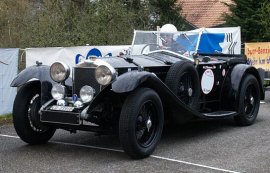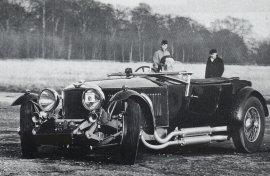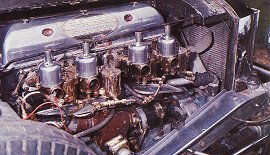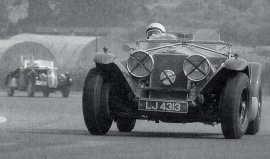
The story of Invicta is, unfortunately, a short
one...

Donald Healey would drive a 4.5 litre Invicta
"S" to victory in the 1931 Monte Carlo
Rally, all the time with a bent chassis...

The sublime 4.5 litre engine of the Invicta was
what made the car so special...

The low centre of gravity was supposed to help
the cars handling, but Sammy Davis (not the singer!)
would definately not agree... |
When writing this series of feature
articles for the Unique Cars and Parts “Lost Marques" section,
invariably some stories will be long, while others
will be perilously short. The story of Invicta falls
into the latter category.
Invicta came to be when Noel
Macklin and Oliver Lyle teamed up in 1925. Macklin
had gained valuable automotive experience when he worked
on the Silver Hawk motorcar project, while Lyle was
a wealthy businessman, his family having established
a large sugar manufacturing concern.
The pair started by designing a car and using the “Coventry-Climax”
2.5 litre six-cylinder engine, although they would soon
standardize on the better known 3 litre “Meadows”
six , the latter engine quickly earning the Invicta
an excellent reputation, particularly for durability
and reliability.
The Meadows power plant helped Invicta’s
win the RAC's coveted Dewar Trophy on two occasions,
and the model became very successful in long-distance
sporting reliability trials.
By 1928 the 4.5 litre model
joined the lineup, Macklin and Lyle intending it to
be a worthy competitor for the illustrious Bentley’s
of the time. In fact, the subsequent “NLC Type”
version of the 4.5 litre Invicta was almost as expensive
as a Rolls-Royce 20/25hp model!
But the depression hit Invicta hard, Macklin and Lyle
realizing quickly that competing with the likes of Rolls
at the upper end of the market had no future. And so
the pair concentrated on development of a far less luxurious
4.5 litre 'High Chassis' tourer.
The new car was launched
in 1930, and was soon joined by a far more sporty “S”
model, usually known as a “Low Chassis”
model. The chassis frame on the “S” passed
underneath the rear axle, which in-turn helped give
the car a lower centre of gravity and more stable handling.
In an unfortunate public relations incident well respected
automotive journalist, Autocar’s Sammy Davis,
was involved in a accident at Brooklands in 1931, when
the handling proved to be anything but stable!
But Macklin remained convinced that the 4.5 litre was
a winner, and was keen to prove the car's reputation
in long-distance touring car events.
In the same year
that Davis came to grief at Brooklands, a young Donald
Healey would enter a 4.5 litre Invicta in the Monte
Carlo rally; Healey would win the rally, in spite of
having to drive it all the way from the start with a
bent chassis following an accident!
Even in basic form, the Meadows engine developed around
120bhp and could propel the car up to nearly 100mph.
By 1934 when the last of Type S cars had been built
(there were 77 Type “S” built in total),
the power output had risen to 140bhp, and the holy grail
of a top speed over 100mph was guaranteed.
The S's successor had been intended to be a magnificent
4.9 litre twin-overhead-cam “SS”, but only
two prototypes of this car were ever built.
Quite simply,
the cost of development was proving too much for the
company, and without adequate backing the company seemed
doomed. Production would effectively end in 1935, although
there were two subsequent attempts to revive it.
Invicta moved from its Cobham, Surrey works in 1933
to Chelsea, southwest of London – the original
factory being used to manufacture the new “Railton”
car. The Railton was the inspiration of Macklin and
Reid Railton, and they decided to retain the famous
Invicta exposed-rivet details on the bonnet panels.
It was, however, a much cheaper affair which utilized
Terraplane and Hudson (of the USA) chassis and mechanical
components. The Railton offered good performance, but
did not have any of the true pedigree of an Invicta.
A similar type of Meadows engine, reduced in size to
3 litres, was then used to create the “Black Prince”
model, but sales would be slow and the inevitable shutdown
would occur. And so the story of Invicta is a short
one, covering only a little over 20 years, but being
ample time for depression and war to conspire against
the success of the company. |



